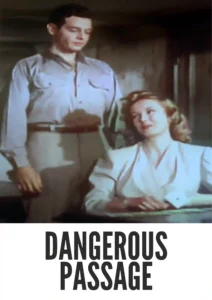Contact: info@alwanfilm.com
Video Sources 0 Views
- Dangerous Passage


Dangerous Passage 1944 Colorized
Synopsis
Table of Contents
ToggleReview: Dangerous Passage 1944 Colorized – A Tense and Suspenseful Noir Thriller

Introduction
Dangerous Passage, released in 1944, is a gripping film noir directed by William Berke. Known for its tense atmosphere, labyrinthine plot, and stellar performances, this classic thriller continues to captivate audiences with its suspenseful narrative. In this review, we’ll explore the dark and treacherous world of Dangerous Passage and its enduring impact on the noir genre.
Check The Full Colorized Movies List
Check Our Colorized Movies Trailer Channel
Understanding Dangerous Passage 1944 Colorized: Director, Cast, and Genre
Directed by William Berke, Dangerous Passage features a talented cast led by Robert Lowery, Phyllis Brooks, and Charles Arnt. The film belongs to the noir genre, characterized by its shadowy visuals, morally ambiguous characters, and bleak outlook on human nature.
Exploring the World of Dangerous Passage 1944 Colorized: Plot and Characters
Dangerous Passage follows the story of a young woman named Kay, who becomes entangled in a web of deception and danger after witnessing a murder. As Kay races against time to unravel the mystery and clear her name, she discovers that nothing is as it seems and that danger lurks around every corner. With its twists and turns, the film keeps viewers on the edge of their seats from start to finish.
The Art of Film Colorization
While Dangerous Passage was originally filmed in black and white, its early colorized version adds a new layer of depth to its atmospheric visuals. The colorization process enhances the film’s tension and suspense, immersing viewers in the dark and treacherous world of noir.
Early Colored Films: A Brief History
The history of early colored films is marked by innovation and experimentation as filmmakers sought to enhance the visual appeal of their movies. From hand-tinted frames to pioneering technicolor processes, the evolution of colorization techniques transformed the cinematic landscape, offering audiences a new way to experience the darkness and intensity of noir.
Dangerous Passage (1944) and Its Early Colored Version
The decision to release Dangerous Passage in a colorized format was made with the intention of immersing audiences in the tension and suspense of its atmospheric cinematography. While some purists may prefer the original black and white version, the early colorized edition of Dangerous Passage adds a new layer of depth to its visual storytelling and enhances the film’s impact on the viewer.
The Debate Over Film Colorization
The debate over film colorization continues to divide audiences and industry professionals alike. While some argue that colorization breathes new life into classic films and makes them more accessible to modern audiences, others maintain that it compromises the artistic integrity of the original work. As technology advances and filmmaking techniques evolve, the debate over colorization remains a topic of ongoing discussion within the film community.
Examining Dangerous Passage (1944) as an Early Colored Film
Viewing Dangerous Passage in its early colorized iteration offers audiences a fresh perspective on its tension-filled narrative and atmospheric cinematography. The colorization process enhances the film’s visual impact and immerses viewers in the dark and treacherous world of noir. As they follow Kay on her perilous journey, they are treated to a cinematic experience that is both thrilling and visually stunning.
Influence and Legacy: Dangerous Passage 1944 Colorized’s Impact on Cinema
Dangerous Passage is widely regarded as a classic example of the noir genre that continues to influence filmmakers and inspire new generations of cinephiles. Its tense atmosphere, labyrinthine plot, and gripping narrative have left an indelible mark on cinema, shaping the way thrillers are made and appreciated to this day.
Director’s Cinematic Legacy: Beyond Dangerous Passage 1944 Colorized
William Berke’s directorial legacy extends far beyond Dangerous Passage, encompassing a diverse body of work that includes acclaimed films such as The Falcon in Danger and The Falcon in Hollywood. As one of the most respected filmmakers of his generation, Berke was known for his ability to craft compelling narratives that kept audiences on the edge of their seats from start to finish. Dangerous Passage stands as a testament to his talent and creativity, solidifying his reputation as one of the great auteurs of classic Hollywood cinema.
Themes Explored in Dangerous Passage 1944 Colorized
At its core, Dangerous Passage explores themes of deception, danger, and the quest for truth in the shadowy world of noir. Through its tense atmosphere and morally ambiguous characters, the film offers a nuanced portrayal of the human condition, challenging viewers to confront their own beliefs about right and wrong as they navigate the treacherous waters of deception and betrayal.
Reception and Controversy Surrounding Dangerous Passage 1944 Colorized
Upon its release, Dangerous Passage received widespread critical acclaim for its tense atmosphere, labyrinthine plot, and gripping performances. While the decision to release the film in a colorized format sparked debate among purists, its enduring popularity has cemented its status as a timeless classic of the noir genre.
Where to Watch Dangerous Passage 1944 Colorized Online
For those eager to experience Dangerous Passage for themselves, the film is readily available on popular streaming platforms such as Amazon Prime Video, Google Play Movies, and iTunes. Whether viewed in its original black and white format or its early colorized iteration, Dangerous Passage offers a cinematic experience that is both thrilling and visually stunning.
FAQs About Dangerous Passage 1944 Colorized
1. Is Dangerous Passage based on a true story?
No, Dangerous Passage is a fictional film that explores the tension and suspense of the noir genre through the eyes of its characters. While the film’s storyline may draw inspiration from real-life events, its plot and characters are works of fiction.
2. Who starred in Dangerous Passage?
Dangerous Passage stars Robert Lowery as the protagonist, Kay, a young woman caught in a web of deception and danger. He is supported by Phyllis Brooks and Charles Arnt in pivotal roles that add depth and complexity to the film’s narrative.
3. What is the central message of Dangerous Passage?
At its core, Dangerous Passage explores the consequences of deception and the quest for truth in the shadowy world of noir. Through its tense atmosphere and morally ambiguous characters, the film offers a nuanced portrayal of the human condition, challenging viewers to confront their own beliefs about right and wrong as they navigate the treacherous waters of deception and betrayal.
4. Why was Dangerous Passage released in a colorized format?
The decision to release Dangerous Passage in a colorized format was made with the intention of immersing audiences in the tension and suspense of its atmospheric cinematography. While some purists may prefer the original black and white version, the early colorized edition of Dangerous Passage adds a new layer of depth to its visual storytelling and enhances the film’s impact on the viewer.
5. What is the legacy of Dangerous Passage?
Dangerous Passage is widely regarded as a classic example of the noir genre that continues to influence filmmakers and inspire new generations of cinephiles. Its tense atmosphere, labyrinthine plot, and gripping narrative have left an indelible mark on cinema, shaping the way thrillers are made and appreciated to this day.
6. Are there any sequels or remakes of Dangerous Passage?
No, there have been no official sequels or remakes of Dangerous Passage. However, the film’s enduring popularity has inspired countless reinterpretations and homages in various media. Nonetheless, none have captured the tension and suspense of the original 1944 classic.
7. Where can I watch Dangerous Passage online?
For those eager to experience Dangerous Passage for themselves, the film is readily available on popular streaming platforms such as Amazon Prime Video, Google Play Movies, and iTunes. Whether viewed in its original black and white format or its early colorized iteration, Dangerous Passage offers a cinematic experience that is both thrilling and visually stunning.
Conclusion
In conclusion, Dangerous Passage (1944) stands as a gripping example of the film noir genre that continues to captivate audiences with its tense atmosphere, labyrinthine plot, and stellar performances. Whether viewed in its original black and white format or its early colorized iteration, William Berke’s insightful direction and the compelling performances of the cast offer a cinematic experience that is both thrilling and visually stunning. As viewers are drawn into the dark and treacherous world of noir, they are treated to a visceral journey that challenges their beliefs about right and wrong and leaves a lasting impact on their understanding of the human condition. Dangerous Passage remains a timeless classic that continues to enthrall and inspire audiences around the world.











